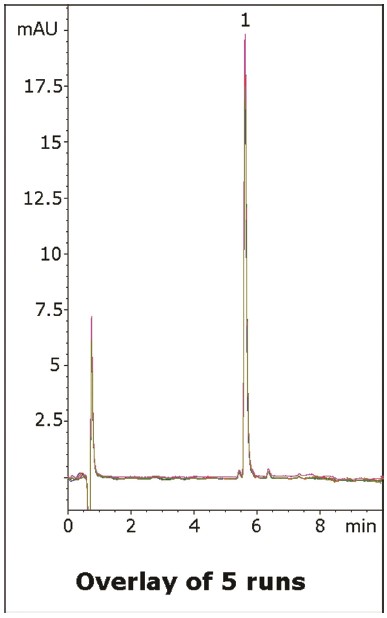LC-MS compatible method
This method for analysis of Hesperidin produces an excellent analyte peak and shows separation from what appears to be two impurity peaks. The gradient method is LC-MS compatible and can be applied to many types of Hesperidin-containing samples such as citrus fruit extracts. The overlay of five runs shown in the figure illustrates the run-to-run reproducibility of the data.


Peak:
Hesperidin
Method Conditions
Column: Cogent Bidentate C18 2.o, 2.2µm, 120Å
Catalog No.: 40218-05P-2
Dimensions: 2.1 x 50 mm
Mobile Phase:
–A: DI Water / 0.1% Formic Acid (v/v)
–B: Acetonitrile / 0.1% Formic Acid (v/v)
Gradient:
| Time (minutes) | %B |
| 0 | 10 |
| 1 | 10 |
| 9 | 70 |
| 10 | 10 |
Post Time: 5 minutes
Injection vol.: 1µL
Flow rate: 0.3mL/minute
Detection: UV @ 285nm
Sample: 100 ppm Hesperidin reference standard in 1:1 DMSO: Methanol diluent
t0: 0.6 minutes
Note: Hesperidin is a naturally occurring glycoside polyphenol that is thought to have antioxidant properties. Studies suggest it may have a number of pharmaceutical applications due to possible anti-inflammatory, anti-cancer, and cholesterol and blood pressure lowering effects. Its name comes from the word “hesperidium”, which is the type of fruit produced by citrus trees.
Attachment
No 289 Hesperidin Analyzed with HPLC pdf 0.3 Mb Download File


